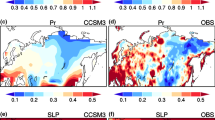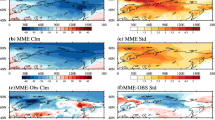Abstract
The present study evaluates the performance of 19 climate models that participated in the coupled model intercomparison project phase 5 (CMIP5) in reproducing climatology, the standard deviation, and the dominant mode of spring surface air temperature (SAT) variations over the mid-high latitudes of Eurasia based on historical runs. Future change of the Eurasian spring SAT under the anthropogenic global warming is also examined by comparing the historical and RCP4.5 run. All the 19 CMIP5 models capture well the observed spatial structure of climatological spring SAT, with the pattern correlation coefficients all larger than 0.94. However, most of the models tend to underestimate the SAT over north Europe and north Siberia and overestimate the SAT south of 50°N. There exists large inter-model spreads in the standard deviation of the spring SAT. Most of the models capture realistically the observed dominant mode of interannual variations of spring SAT. Analyses show that the ability of a CMIP5 model in capturing the dominant mode of Eurasian spring SAT variations is connected with the model’s performance in representing the observed atmospheric circulation anomalies related to the Arctic Oscillation and the dominant mode of the atmospheric variations over Eurasia. Six best models are selected based on the ability in simulating the dominant mode of the spring SAT variations in the historical runs. These six models project an increase in the SAT climatology but a decrease in the standard deviation over most of Eurasia. These six models project a decrease in the explained variance as well as in the amplitude of the spring SAT and atmospheric anomalies related to the dominant mode.


















Similar content being viewed by others
References
Barriopedro D, Fischer EM, Luterbacher J, Trigo RM, García-Herrera R (2011) The hot summer of 2010: redrawing the temperature record map of Europe. Science 332:220–224. https://doi.org/10.1126/science.1201224
Caloiero T (2017) Trend of monthly temperature and daily extreme temperature during 1951–2012 in New Zealand. Theor Appl Climatol 129:111–127
Chen SF, Wu R (2018) Impacts of early autumn Arctic sea ice concentration on subsequent spring Eurasian surface air temperature variations. Clim Dyn. https://doi.org/10.1007/s00382-017-4026-x
Chen SF, Yu B, Chen W (2014) An analysis on the physical process of the influence of AO on ENSO. Clim Dyn 42:973–989
Chen W, Hong X, Lu R, Jin A, Jin S, Nam J, Shin J, Goo T, Kim B (2015) Variation in summer surface air temperature over northeast Asia and its associated circulation anomalies. Adv Atmos Sci 33:1–9. https://doi.org/10.1007/s00376-015-5056-0
Chen SF, Wu R, Liu Y (2016) Dominant modes of interannual variability in Eurasian surface air temperature during boreal spring. J Clim 29:1109–1125. https://doi.org/10.1175/JCLI-D-15-0524.1
Chen SF, Chen W, Yu B (2017) The influence of boreal spring Arctic Oscillation on the subsequent winter ENSO in CMIP5 models. Clim Dyn 48:2949–2965
Cheung HN, Zhou W, Mok HY, Wu MC (2012) Relationship between Ural–Siberian blocking and the East Asian winter monsoon in relation to the Arctic Oscillation and the El Niño-Southern Oscillation. J Clim 25:4242–4257
D’Arrigo R, Wilson R, Li J (2006) Increased Eurasian-tropical temperature amplitude difference in recent centuries: Implications for the Asian monsoon. Geophys Res Lett 33:L22706. https://doi.org/10.1029/2006GL027507
Dee DP et al (2011) The ERA-Interim reanalysis: configuration and performance of the data assimilation system. Q J R Meteorol Soc 137:553–597. https://doi.org/10.1002/qj.828
Duchon C (1979) Lanczos filtering in one and two dimensions. J Appl Meteorol 18:1016–1022
Feudale L, Shukla J (2010) Influence of sea surface temperature on the European heat wave of 2003 summer. Part I: an observational study. Clim Dyn 36:1691–1703. https://doi.org/10.1007/s00382-010-0788-0
Gong DY, Wang SW, Zhu JH (2001) East Asian winter monsoon and Arctic oscillation. Geophys Res Lett 28(10):2073–2076
Graf HF, Zanchettin D (2012) Central Pacific El Niño, the “subtropical bridge”, and Eurasian climate. J Geophys Res 117:D01102. https://doi.org/10.1029/2011JD016493
Guan Y, Zhang X, Zheng F, Wang B (2015) Trends and variability of daily temperature extremes during 1960–2012 in the Yangtze River Basin, China. Glob Planet Change 124:79–94
Guo Y, Zhao Z, Dong WJ (2016) Two dominant modes of winter temperature variations over China and their relationships with large-scale circulations in CMIP5 models. Theor Appl Climatol 124:579–592
Henderson-Sellers A (1996) Soil moisture: a critical focus for global change studies. Glob Planet Change 13:3–9
Huang R, Sun F (1992) Impacts of the tropical western Pacific on the East Asia summer monsoon. J Meteorol Soc Jpn 70:243–256
IPCC (2013) Summary for policymakers. Fifth Assessment Report of the Intergovernmental Panel on Climate Change. Cambridge University Press, Cambridge
Jia XJ, Lin H (2011) Influence of forced large-scale atmospheric patterns on surface air temperature in China. Mon Weather Rev 139:830–852
Kanamitsu M, Ebisuzaki W, Woollen J, Yang SK, Hnilo J, Fiorino M, Potter G (2002) NCEP–DOE AMIP-II reanalysis (R-2). Bull Am Meteorol Soc 83:1631–1643. https://doi.org/10.1175/BAMS-83-11-1631
Keellings D, Waylen P (2012) The stochastic properties of high daily maximum temperatures applying crossing theory to modeling high-temperature event variables. Theor Appl Climatol 108:579–590
Kunkel KE, Roger AP, Stanley AC (1999) Temporal fluctuations in weather and climate extremes that cause economic and human health impacts: a review. Bull Am Meteorol Soc 80:1077–1098
Li T, Du Y, Mo Y et al (2014) Human health risk assessment of heat wave based on vulnerability: a review of recent studies. J Environ Health 31:547–550 (in Chinese)
Liu X, Yanai M (2001) Relationship between the Indian monsoon rainfall and the tropospheric temperature over the Eurasian continent. Q J R Meteorol Soc 127:909–937. https://doi.org/10.1002/qj.49712757311
Matsueda M (2011) Predictability of Euro-Russian blocking in summer of 2010. Geophys Res Lett 38:L06801. https://doi.org/10.1029/2010GL046557
Matsuura K, Willmott CJ (2009) Terrestrial air temperature: 1900–2008 gridded monthly time series (version 4.01). University of Delaware Dept. of Geography Center. http://www.esrl.noaa.gov/psd/data/gridded/data.UDel_AirT_Precip.html. Accessed 6 Aug 2015
Miyazaki C, Yasunari T (2008) Dominant interannual and decadal variability of winter surface air temperature over Asia and the surrounding oceans. J Clim 21:1371–1386. https://doi.org/10.1175/2007JCLI1845.1
Nitta T (1987) Convective activities in the tropical western Pacific and their impact on the Northern Hemisphere summer circulation. J Meteorol Soc Jpn 65:373–390
North GR, Moeng FJ, Bell TL, Cahalan RF (1982) The latitude dependence of the variance of zonally averaged quantities. Mon Weather Rev 110:319–326
Ogi M, Tachibana Y, Yamazaki K (2003) Impact of the wintertime North Atlantic Oscillation (NAO) on the summertime atmospheric circulation. Geophys Res Lett 30:1704. https://doi.org/10.1029/2003GL017280
Stott PA, Stone DA, Allen MR (2004) Human contribution to the European heatwave of 2003. Nature 432:610–614. https://doi.org/10.1038/nature03089
Sun J, Wang H, Yuan W (2008) Decadal variations of the relationship between the summer North Atlantic Oscillation and middle East Asian air temperature. J Geophys Res 113:D15107
Sun Y, Zhang X, Zwiers F, Song L, Wan H, Hu T, Yin H, Ren G (2014) Rapid increase in the risk of extreme summer heat in Eastern China. Nat Clim Change 4:1082–1085
Taylor KE (2001) Summarizing multiple aspects of model performance in a single diagram. J Geophys Res 106:7183–7192
Taylor KE, Stouffer RJ, Meehl GA (2012) An overview of CMIP5 and the experiment design. Bull Am Meteorol Soc 93(4):485–498
Thompson DW, Wallace JM (1998) The Arctic Oscillation signature in the wintertime geopotential height and temperature fields. Geophys Res Lett 25:1297–1300. https://doi.org/10.1029/98GL00950
Thomson AM, Calvin KV, Smith SJ, Kyle GP, Volke A, Patel P, Delgado-Arias S, Bond-Lamberty B, Wise MA, Clarke LE (2011) RCP4.5: a pathway for stabilization of radiative forcing by 2100. Clim Change 109(1):77–94
Wang B, Wu ZW, Chang CP, Liu J, Li J, Zhou T (2010) Another look at interannual-to-interdecadal variations of the East Asian winter monsoon: the northern and southern temperature modes. J Clim 23:1495–1512
Webster PJ, Yang S (1992) Monsoon and Enso: selectively interactive systems. Q J R Meteorol Soc 118(507):877–926
Wu R, Chen SF (2016) Regional change in snow water equivalent–surface air temperature relationship over Eurasia during boreal spring. Clim Dyn 47:2425–2442
Wu B, Wang J (2002) Winter Arctic oscillation, Siberian high and East Asian winter monsoon. Geophys Res Lett 29(19):1897. https://doi.org/10.1029/2002GL015373
Wu ZW, Wang B, Li J, Jin FF (2009) An empirical seasonal prediction model of the East Asian summer monsoon using ENSO and NAO. J Geophys Res 114:D18120. https://doi.org/10.1029/2009JD011733
Wu R, Yang S, Liu S, Sun L, Lian Y, Gao Z (2011) Northeast China summer temperature and North Atlantic SST. J Geophys Res 116:D16116. https://doi.org/10.1029/2011JD015779
Wu ZW, Zhang P, Chen H, Li Y (2016) Can the Tibetan Plateau snow cover influence the interannual variations of Eurasian heat wave frequency? Clim Dyn 46:3405–3417
Xia JJ, Tu K, Yan ZW, Qi Y (2016) The super-heat wave in eastern China during July–August 2013: a perspective of climate change. Int J Climatol 36:1291–1298
Xu MM, Xu HM, Ma J (2016) Responses of the East Asian winter monsoon to global warming in CMIP5 models. Int J Climatol 36:2139–2155
Yao PZ (1995) The climate features of summer low temperature cold damage in northeast China during recent 40 years. J Catastrophol 10:51–56 (in Chinese)
Ye L, Yang G, Van Ranst E, Tang H (2013) Time-series modeling and prediction of global monthly absolute temperature for environmental decision making. Adv Atmos Sci 30:382–396
Zeng J, Zhai Y, Wu Z, Hu K (2011) Effects of high temperature in summer on yield and its components in bitter gourd with 15 cross combinations and strains. Chin J Trop Crops 32:2025–2028 (in Chinese)
Zhou Y, Wu ZW (2016) Possible impacts of mega-El Niño/Southern Oscillation and Atlantic multidecadal oscillation on Eurasian heat wave frequency variability. Q J R Meteorol Soc 142:1647–1661
Zuo J, Ren HL, Wu BY, Li WJ (2016) Predictability of winter temperature in China from previous autumn Arctic sea ice. Clim Dyn 47:2331–2343
Zveryaev II, Gulev SK (2009) Seasonality in secular changes and interannual variability of European air temperature during the twentieth century. J Geophys Res 114:D02110. https://doi.org/10.1029/2008JD010624
Acknowledgements
We thank two anonymous reviewers for their constructive suggestions and comments, which helped to improve the paper. We also thank Mr. Shijie Zhou for providing outputs of the CMIP5 RCP4.5 experiments. This study is supported by the National Natural Science Foundation of China Grants (41605050, 41530425, 41775080, and 41661144016), and the Young Elite Scientists Sponsorship Program by the China Association for Science and Technology (2016QNRC001). We acknowledge the World Climate Research Programme’s Working Group on Coupled Modeling, which is responsible for CMIP, and we thank the climate modeling groups (listed in Table 1 of this paper) for producing and making available their model output. For CMIP, the U.S. Department of Energy’s Program for Climate Model Diagnosis and Intercomparison provides coordinating support and leads development of software infrastructure in partnership with the Global Organization for Earth System Science Portals.
Author information
Authors and Affiliations
Corresponding author
Electronic supplementary material
Below is the link to the electronic supplementary material.
Rights and permissions
About this article
Cite this article
Chen, S., Wu, R., Song, L. et al. Present-day status and future projection of spring Eurasian surface air temperature in CMIP5 model simulations. Clim Dyn 52, 5431–5449 (2019). https://doi.org/10.1007/s00382-018-4463-1
Received:
Accepted:
Published:
Issue Date:
DOI: https://doi.org/10.1007/s00382-018-4463-1




